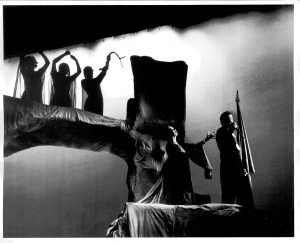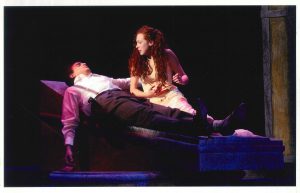
Perhaps the best known and most oft quoted line of legendary English playwright William Shakespeare (1564-1616) is “To be, or not to be, that is the question.” For the Drama Department of The Catholic University of America (CUA) the question was decisively answered with its founding in 1937 by the brilliant and charismatic Gilbert V.F. Hartke (1907-1986), the “Show-Biz Priest,” subject of a recent blog post by my colleague Maria Mazzenga. With the work of Shakespeare a staple, Hartke, a D.C. icon, directed over sixty CUA productions and many more for the National Players, his touring company. He also wrote five plays and toured with his students both nationally and internationally. Today, the theatre at Catholic University bears his name and is still performing Shakespeare on an almost biennial rate.

The last play of the 2016-2017 season, coinciding with the 80th anniversary of the CUA Drama Department, is the return of MacBeth, otherwise known as ‘The Scottish Play’ or ‘The Bard’s Play’ to Hartke Theater for the first time since 2004. Anticipation of this event prompted me to examine the rich history of Shakespeare at CUA. While there were small scale performances of The Bard’s plays by various student groups before the Drama Department was created in 1937, the focus here is on the larger scale productions of CUA Drama since then, in particular because the CUA Archives preserves so many of the records, including photographs, programs, prompt books, reviews , cast lists, scene breakdowns, an and analysis of the plays. The 37 known Shakespeare plays are divided into three genres, with about a dozen each as comedies, tragedies, and histories. CUA Drama has performed nineteen of the plays, many multiple times in the eighty seasons culminating with MacBeth in 2017.

CUA’s focus has been primarily on the tragedies, performing nine of them to date:: Coriolanus 1938-1939 and 1961; Cymbeline 2011; Hamlet 1956; Julius Caesar 1953, 1962-1963, 1972, and an abridged version called Brutus, 2012-2013; King Lear 1948-1949; MacBeth 1952, 1976, 2004, 2017; Othello 1951,1960; Romeo and Juliet 1949-1950, 1960, 1980, 2000, 2007; and The Tempest 1951-1952, 1968-1969. The most performed play is Romeo and Juliet. A Washington Post reviewer found the first production in 1949 to be “performing smoothly” and ‘commendably faithful”¹, but more recent efforts have been quite innovative, including an interracial version in 2000, jointly produced with Howard University, and the 2007 show set in twentieth century Fascist Italy.

The comedies are also well represented, with seven featured so far: As You Like It, 1964-1965, 1986, 1997; Love’s Labor Lost 1986, 2005; Merchant of Venice 1957-1958, 1978, 2014; Midsummer Night’s Dream 1959, 1979, 2001; Much Ado About Nothing 1946-1947, 1993; Taming of the Shrew 1959, 1984; and Twelfth Night 1956, 1982, 2003. As with the tragedies, the comedies were generally well reviewed, with the Evening Star stating that the 1959 production of A Midsummer Night’s Dream showed “a proper respect for the imagination of audiences.”² Less attention however has been paid to the histories, with only three performed to date: Henry IV 1953-1954, Richard II 1965-1966, and Richard III 1954-1955, 1988-1989. A finding aid, or collection guide, for the papers of Fr. Hartke is available online. For more information on the CUA Drama Department records please email lib-archives@cua.edu.
¹Richard Coe. The Washington Post, November 7, 1949, p. 12.
²Harry MacAthur. The Evening Star, December 7, 1959, p. C-6.
